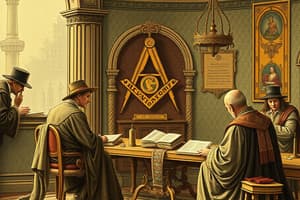Podcast
Questions and Answers
Which type of joint in masonry is specifically designed to address lateral stability and structural integrity?
Which type of joint in masonry is specifically designed to address lateral stability and structural integrity?
- Bed joint
- Articulation joint (correct)
- Control joint
- Expansion joint
What is the maximum volume percentage for a depression in a masonry unit to be considered acceptable?
What is the maximum volume percentage for a depression in a masonry unit to be considered acceptable?
- 35%
- 25% (correct)
- 15%
- 40%
Which term describes highly workable concrete placed within masonry to enhance its structural properties?
Which term describes highly workable concrete placed within masonry to enhance its structural properties?
- Surface concrete
- Infill concrete (correct)
- Joint filler
- Poured concrete
What is the purpose of a bed joint in masonry construction?
What is the purpose of a bed joint in masonry construction?
How does an articulation joint function in relation to wall panels?
How does an articulation joint function in relation to wall panels?
Which bond features a systematic arrangement where alternating courses are aligned vertically with headers laid between stretcher courses?
Which bond features a systematic arrangement where alternating courses are aligned vertically with headers laid between stretcher courses?
Which masonry bond allows for the placement of reinforcement in a cavity created by its pattern?
Which masonry bond allows for the placement of reinforcement in a cavity created by its pattern?
In which masonry bond does each unit overlap the one below at the midpoint of the unit?
In which masonry bond does each unit overlap the one below at the midpoint of the unit?
What is a defining characteristic of the honeycomb bond?
What is a defining characteristic of the honeycomb bond?
Which bond is specifically described as having perpend joints aligned vertically in every alternate course?
Which bond is specifically described as having perpend joints aligned vertically in every alternate course?
Study Notes
Definitions and Concepts
- Frog: A depression in masonry faces not exceeding 25% of the unit's gross volume.
- Infill Concrete: Highly workable concrete used to fill cores and cavities in masonry for reinforcement.
Types of Joints in Masonry
- Articulation Joint: Allows wall panels to move without damage, accounting for lateral stability and structural integrity.
- Bed Joint: A horizontal mortared joint between masonry courses.
Masonry Bonds
- English Bond: Alternates between stretcher and header courses.
- English Garden Wall Bond: Features headers placed between stretcher courses, with vertical intervals not exceeding 450 mm.
- Honeycomb Bond: Features openings at the center of each unit, with overlaps in successive courses.
- Quarter Bond: Each alternate course is offset by one-quarter of the unit's length.
- Quetta Bond: Alternating T-pattern for staggering courses, allowing reinforcement placement within cavities.
- Rat-Trap Bond: Staggered hollow square pattern with overlaps equal to one-quarter of the unit.
- Stretcher Bond: Overlaps the unit below at midpoints.
Materials and Compliance Standards
- Cement:
- Common cements must comply with SANS 50197-1.
- Masonry cements follow SANS 50413-1 guidelines.
- Lime for Mortar: Must meet SANS 523 requirements (A2P type).
- Sand Requirements:
- No organic materials and must pass a sieve with a 5mm mesh.
- Must exhibit proper workability when mixed with cement (2.5 kg to 12.5 kg ratio requires no more than 3.0 L of water for masonry laying).
Wall Ties Specifications
- Non-Metallic Ties: Must resist tensile forces of 0.6 kN and compressive forces of 0.7 kN under testing conditions, ensuring stiffness under load.
Structural Requirements
- Steel Frames: Door and window frames need to comply with SANS 1129 and SANS 727.
- Bonding of Walls: Intersecting masonry must be bonded with full masonry bonds or tied with galvanized hoop-iron straps at maximum intervals of 450 mm.
Additional Construction Guidelines
- Galvanized Straps: Minimum dimensions are 1.2 mm thickness, 30 mm width, and 700 mm length.
- Joining New to Existing Masonry: Dowels are required for secure connections.
- Bonding Details: Ties for piers and ribs must follow specific guidelines, including solidly filling collar joints with mortar and filling hollow unit cores with mortar or infill concrete.
General Construction Practices
- Raking Back: Advanced work corners must not exceed 1 m in height above general masonry level, prohibiting toothing-in methods for joining walls.
Studying That Suits You
Use AI to generate personalized quizzes and flashcards to suit your learning preferences.
Related Documents
Description
Test your knowledge on key definitions, types of joints, and various masonry bonds. This quiz covers essential masonry concepts that are vital for construction and architecture. Gain a better understanding of how different masonry methods contribute to structural integrity.




